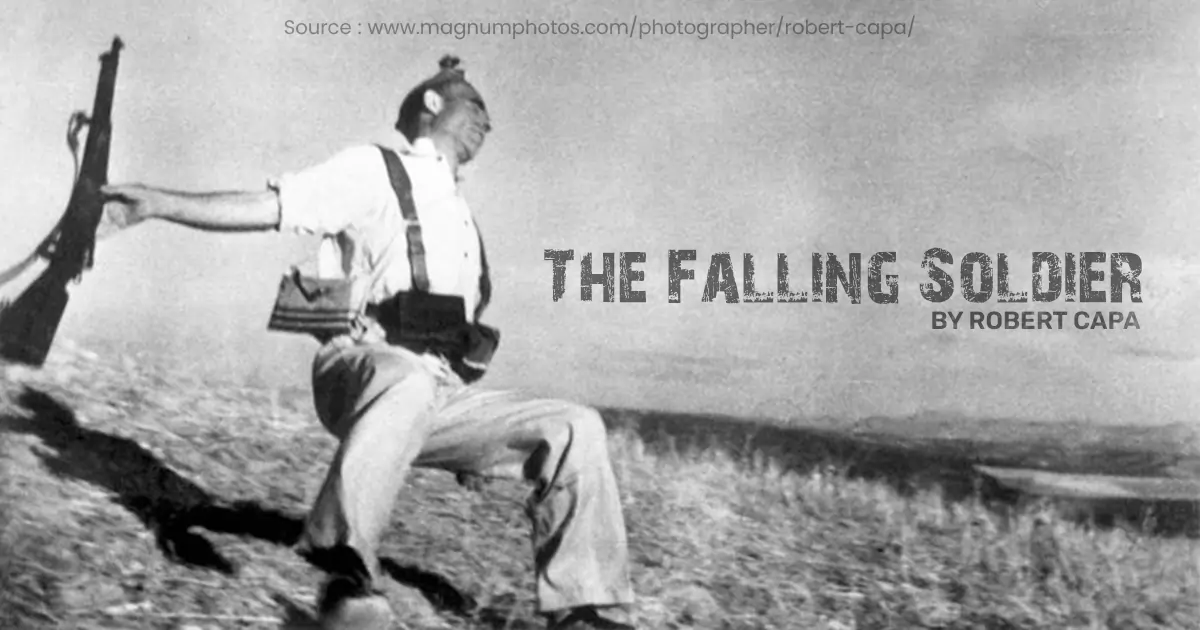11 Inspiring Famous Photojournalists’ Photo Stories

Read | Loved by: 51114

Photographer. I like to call it a frame of memories. From good to bad every photo is available in frame. If you have a camera then go through that. You will have some beautiful memories for sure. But if you’re a Gen Z then I’m sure you were surrendered by clicking pictures all the time. You will find memories everywhere. That’s amazing to think. But do you know there are some historical photos by famous photojournalists that marked its footsteps?
There are many images that played a great role in creating history. But very few had left an impact on people’s thought processes. All the credit goes to some talented and heroic photojournalists. Let’s talk about some of the greatest and famous photojournalists of all time.
What is Journalism?
Journalism is collecting news, preparing it to distribute, and finally distributing it to the perfect audience. A Journalist’s job is to ensure catching authentic news and distributing it to the targeted society. A journalist's job is to collect the information that he can analyze and provide it to the audience.
What is Photo Journalism?
Doing journalism with the help of photos is what photojournalism is. Telling a story through pictures is a work of photojournalism. Journalism is when the story is told with the help of paper and ink. When the work is done by using a camera then it becomes photojournalism, and the same work becomes broadcast journalism when it is done with videos instead of still pictures.
Famous Photojournalists
Today's date, we are 1 step away from any kind of information we want. Journalism! We can grab the news and updates from Facebook, YouTube, and other social platforms. Since everyone has a camera nowadays it's not that hard to get news immediately. But back in time, it was not a piece of cake for a person to get information immediately. Sometimes people even had to risk their lives to get exclusive news. Let’s talk about some of the heroic photojournalists.
1. Henri Cartier Bresson
Henri Cartier Bresson was born in Cantaloup-en-Brie, Seine-et-Marne, France. He went to a school near Paris. His photography made a unique position for himself in the photography field. His first exhibition was at the Julien Levy Gallery in New York. He was so talented in his work of photography that his photographs can let the stories beneath outward appearance. This talent made his hand long in his photography career. He has traveled a lot for his photography career and highlighted some great events.

In 1933 he was traveling in Seville, Spain, when he came across a ruined building. Usually, the remains of a building is not a very pleasant place to hang around. But he found some children who were happy to find a place where they could play. Despite the situation of the building, they were happy to play. Henri Cartier Bresson captured the happiness in a framic form which also made the picture unique since it gives the audience a new viewing point.
2. Dorothea Lange
Dorothea Lange was born in Hoboken, New Jersey. At the age of seven, she contracted polio, which resulted in her right leg being permanently weak to bear her weight. She graduated from a school in New York City. At that time, she was determined that she would become a photographer, even though she didn't own a camera at that time. then she studied photography at Columbia University. Lange is famous for her work in 1933 during the Depression era, when many people were jobless, and many lost their families and home.

During the depression era when many people lost their jobs and struggled for the bare minimum, Dorothea Lange came across "PEA-PICKERs CAMP" in California in early March 1936. There poverty was at its peak. Dorothea saw a mother with 7 children there. Her name was Florence Owens Thompson. Florence was 32 years old back then. She was a migrant and fighting against hunger with her children. On this incident, Dorothea said, "She said that they had been living on frozen vegetables from the surrounding field and birds that the children killed." Dorothea took several pictures but this one stood up from them since the mother’s struggle was visually strong and could be seen in this image.
3. Margaret Bourke White
Margaret Bourke-White was born on 14 June 1904. She was an American photographer and also a documentary photographer, who is famous for her Soviet industry under the Soviets' first five-year plan pictures. She was the first foreigner to cover the documentary. Her pictures were so powerful that they took the place of the cover of the first issue of Life magazine. Later she also served for Life in the Korean War.

The interesting fact is this picture of Mahatma Gandhi is pretty famous and probably we all have seen it at least once before. But this picture was not a piece of art when it was taken. It was published after quite a time. Even then it didn't catch the eye of the audience since it was realized in a small size in the magazine. But in 1948, after the assassination of Gandhi, the picture came to the public's attention. Life's multiple pages the picture was used to tribute M K Gandhi. Soon the picture became one of the most famous pictures of all time.
4. Robert Capa
Robert was a famous photographer who was famous for his work of documenting wars. He was in a total of 5 wars in his lifetime career. He covered The Spanish Civil War, the Second Sino-Japanese War, World War II across Europe, the 1948 Arab-Israeli War, and the First Indochina War. His pictures draw the line of the span between life and death. He even died a heroic death, holding the camera in his hand and taking pictures in the first Indochina War in 1954.

This image was taken by Robert Capa in 1948 in Israel. It was taken when Capa came to witness and photograph the situation after the declaration of the State and the War of Independence. After the war, Capa kept visiting the camps of Israel to document the waves of immigration. The transits that happened after the war. The uncertainty faced by the new Jewish nation.
5.Nick Ut
Huỳnh Công Út, also known as Nick Ut is a Vietnamese-American photojournalist. He worked for Associated Press also known as AP in Los Angeles, when he was just 16 years old. He has won many awards during his work life. He was awarded the Pulitzer Prize for Spot News Photography in 1973 and World Press Photo of the Year in 1973. He won both prizes for his ‘The Terror of War’ photo. History can't be changed by one single person. There needs to be more than one person's involvement. Photographers play a vital role in changing history. Nick Ut is one of them.

Nick Ut's award-winning photo 'The Terror of War' is also known as 'Napalm Girl'. During the war, Nick went there to capture photographs of the refugees and plan a boom dropping from the planes. At the time of the bomb exploding everywhere, villagers ran out and hid in the temples to save themselves.
All of a sudden, a plane dropped a napalm bomb in that area. People were getting hit by the bomb and running from there getting hit by the bombs. Mothers were caring for their burned children. At that moment Nick saw a group of terrified children running and crying out of fear.
Among them, there was a naked 9-year-old girl named Phan Thị Kim Phúc. She got burned. her skin was falling off. Nick put his camera aside and brought water for the girl and took her and the other children to the hospital. She was so burned that the hospital said they would not be able to save her. She had suffered third-degree burns. thirty percent of her body was burned. So, Nick took her to an American hospital where they saved her life.
6.Steve McCurry
Steve McCurry is an American photojournalist, born on February 24, 1950, in Philadelphia, Pennsylvania. He wanted to study cinematography and filmmaking, but he eventually gained a degree in theater arts. But his career took off when he disguised in Afghani garb. He risked his life for photojournalism. Just before the Soviet invasion, he crossed the Pakistan border and entered rebel-controlled areas of Afghanistan. His clicked pictures were published by The New York Times, Times, and Paris Match. He also won the Robert Capa Gold Medal for his outstanding photojournalism from abroad.

The girl in the photo of 'Afghan Girl' is Sharbat Gula. She was an Afghan refugee staying in Pakistan at the time of the Soviet-Afghan War. It was taken near the Pakistani city of Peshawar. It became the cover of National Geographic in June 1985. Was a 12-year-old girl at the time of taking the photo. But she was unidentified till 2002. Though McCurry attempted several times to find the famous unknown girl, he failed to do so. In 2002 finally, the National Geographic team found her in Afghanistan. She went back to her hometown after the war.
7. Kevin Carter
Kevin Carter was a rebel photojournalist in South Africa and also a member of the Bang-Bang Club. A small paragraph is not enough to talk about him. He grew up in a middle-class family and most of his neighbors were white. He grew up in a place where black people were illegally leaving, He saw the discrimination that happens often to black people. In 1980, at a restaurant he witnessed a black waiter being insulted and he stood up for the person which resulted in him being beaten up by the other servicemen. He committed suicide just after four months after receiving the award of the Pulitzer Prize for Feature Photography. He poisoned himself to death.

This picture is known as ‘The Vulture and the Little Girl’. This is the great picture that made Kevin popular, that made him one of the most remarkable photojournalists of all, this is the picture that got him the Pulitzer Prize for Feature Photography. Unfortunately, this is the same picture that played with Kevin’s mental health and ended up with Kevin taking his own life. He took this picture in Sudan. A little girl starving and trying to find food when a Vulture is waiting for her death to make her his food. This image could wrench anyone's heart immediately. This story even made me emotional.
8. Stephanie Sinclair
Stephanie Sinclair was born in Miami, Florida. She is mostly known for her photo series 'Too Young to Wed'. It showed child marriage in more than 50 countries in the world. This project took her 15 years of work in Afghanistan, Nepal, Ethiopia, India, Yemen, Guatemala, and Nigeria. In 2012, along with Jessica Dimmock, she made a documentary on the same issue. They featured an Ethiopian girl married at age 11.

The above picture was taken by Stephanie Sinclair and shows 2 child brides. They are in a rural area in Yemen with their husbands. The girl standing behind in the pink dress is Tahani. She is 8 years old, standing with her 27-year-old husband Majed. In the front line, the girl in a green dress is also 8 years old. She is also a child bride and stands with her 33-year-old husband Sultan. Can you imagine the scenario of Yemen and other countries that are still allowing or silent about child marriages? This image became famous not only because of the background, it is also because of the standing position and eye contact they are making with the camera. Stephine had to convince them to take such a picture. Hats off to her.
9. Rena Effendi
Rena Effendi was born in Baku, Azerbaijan. She is a world-famous Turkish photojournalist who focuses on various aspects of social justice, conflicts, and the environment. Rena documented how a multibillion-dollar project impacted impoverished fishermen, farmers, and other citizens.

This photo was taken in 2006 by Rena in Khinalugs. It showcases a beautiful family. The story behind the picture is completely different. In Khinalugs there was a road going to be built. Rena went there just before the road was going to be built in 2006. Then she took this picture of a family. Then she went back in 2009. Then she took some more pictures of the houses in Khinalugs. In those pictures, she focuses on the daily activities of rural life.
10. Eddie Adams
Edward Thomas Adams was an American photojournalist who was known for his photography work the summary execution of Nguyễn Văn Lém. He was born on June 12, 1933, in Pennsylvania. He also won the Pulitzer Prize for Spot News Photography in 1969. He also won the World Press Photo award for the same photo.

This is the very famous photo of ‘The Summary Execution of Nguyễn Văn Lém’. At first glance, the picture might seem like the execution of an innocent man. But the case is totally opposite. This image can be a great example of how a picture can lie. How a picture can be manipulated with someone’s brain.
The image seems like it was taken in the Vietnam War. A general is brutally killing an innocent man in the name of war. The fear of being killed was very much clear in the man’s expression. And this picture also helps the Vietnam War to end. It somewhat did affect the war. But the real story of the picture that Adams told to the media was the exact opposite of what we are looking at.
The man being executed is Nguyễn Văn Lém. He was a Con Viet. He was the leader of a Viet Cong death squad. He used to kill the South Vietnamese National Police officers and their families. On that specific day, he was caught red-handed. He was known as Captain Bay Lop. Major General Nguyen Ngoc Loan caught Lem and soon he was executed for his crimes.
The story could have ended here. But that doesn’t end here. The picture went viral. But not the real story behind it. Later on, Eddie Adams also said he wished he didn’t take the picture. He also didn’t know at the time what he had captured until it was developed. The general had to go through a lot of terrible situations because of the picture. He was refused treatment, he was forced to retire which he opened after his officer career, and he was neglected by society. Even Eddie Adams regrets taking the picture.
He said “The General killed the Viet Cong; I killed the general with my camera. Still, photographs are the most powerful weapon in the world. People believe them; but photographs do lie, even without manipulation. They are only half-truths. What the photograph didn’t say was, “What would you do if you were the General at that time and place on that hot day, and you caught the so-called bad guy after he blew away one, two, or three American soldiers?”
11. Gordon Parks
Gordon Parks was born on November 30, 1912. His full name was Gordon Roger Alexander Buchanan Parks. He was an American Photojournalist, who was also a composer, author, and film director. He documented the life of African Americans in America. They were mostly based on the particular issue of civil rights. He is also known as the first black American filmmaker to direct films in Hollywood. However, he is mostly famous for his iconic photo of poor Americans during the 1940s.

For Parks, the camera was a weapon to fight against the discrimination that was happening in America against African Americans. This photo is also called the Harlem Rally. This picture was taken 60 years ago. It was taken in a predominantly black New York neighborhood in 1963. It was probably in a time of protest for civil rights in the US.
Conclusion
Famous photo journalists have the power to influence people with their works of art. You can see all the above-mentioned photojournalists are remarkably talented in their own subjects. Their photos were so powerful that they made bold statements to the public and placed themselves in a position where they were able to have an impact on society. Life magazine photography holds most of the above photos in the first place to cover.
If you want your picture to be perfect like the professional, then you can take the help of photo editing and photo retouching. Photo editing and retouching are not that big of a deal if you do it properly. But if you are scared to do it by yourself, then you can knock at Color Clipping, anytime you want.
FAQ

Anika Wahab
Hello, it's Anika, Content Executive from Color Clipping Ltd with a devotion to contributing my skills and knowledge more simply. Keep learning and growing with us.



